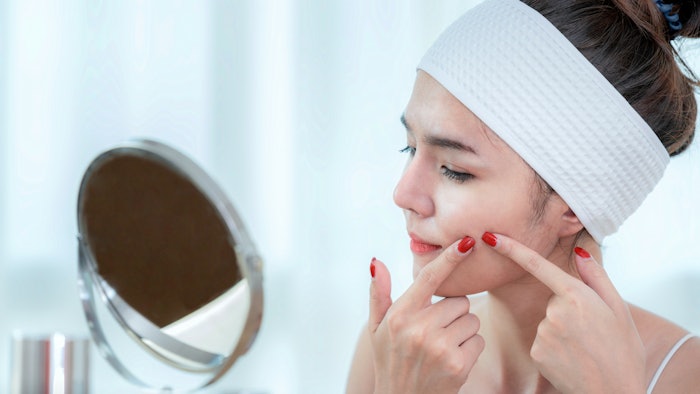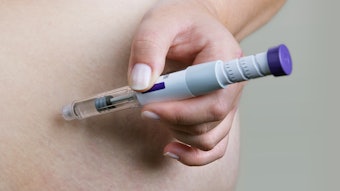
In skin care, it is important not to rely on common trends for all skin care services. Let's discover what differentiates the trends versus the treatments. Ask yourself if your are using your treatments as trends? An example of using treatments as trends would be if you are recommending and performing the same service on every client regardless of their skin conditions and concerns.
The question we are answering today is: Should there be an acne treatment/facial on your menu? Many treatments in skin care are amazing on specific skin types and conditions, but if used on everyone, you may be offering it because it's trendy, which may not be helpful to the skin. A good rule of thumb when analyzing the skin and creating the treatment plan is to ask yourself is:
- Why am I recommending this treatment?
- How will this treatment help my client?
If you can answer the question, it's safe to say you can proceed.
Related: The Do's and Don'ts of Treating Acne Clients
Understanding Acne
To help understand the differentiation between the different terms, I gathered some definitions.
Trend. "A prevailing tendency or inclination," "a current style or preference" or "a line of development."1
Treatment. The action or way of treating a patient or a condition medically or surgically: management and care to prevent, cure, ameliorate, or slow the progression of a medical condition.
Facial. The textbook definition of a facial, according to the latest Milady's 2020 textbook, is A professional service designed to improve the appearance of the facial skin.
Acne. It is an inflammatory condition of the sebaceous glands that is medically known as acne simplex. Acne is characterized by: congestion of the follicle- sebaceous filaments, blackheads, whiteheads, papule, pustule and cysts.
Inflammation cascade. The Inflammation Cascade, also known as the arachidonic cascade, is a series of biochemical mediators' reactions in the skin when inflamed. The inflammation cascade is always present with inflamed acne. When a cell is inflamed, it releases inflammatory mediators; then the skin releases leukocytes or white blood cells; the white blood cells release a particular chemical called cytokines, which signal cells to release self-destruct enzymes called matrix metalloproteinases (MMPs). MMPs break down substances in the skin responsible for smoothness, firmness in the skin, and moisture content, such as collagen elastin and hyaluronic acid. There are two types of inflammation cascade:
1. Clinical Inflammation cascade. This is when you see the client, the inflammation will be visible, and you will be made aware that they are experiencing inflammation due to redness and lesions. So, they are in the inflammation cascade.
2. Subclinical inflammation cascade. You will not be able to look at the skin and know that the client has inflammation without a trained eye, analysis and consultation. The inflammation is not visible. This happens when the client has had too many treatments like chemical peels, microneedling, microdermabrasion or any therapy that encourages positive or enhancing substances in the skin, such as collagen elastin and hyaluronic acid. It is imperative to avoid over-treating the skin and to allow the skin to heal in between treatments. Skin in the inflammation cascade is primarily due to conditions like acne. Inflammation in the skin triggers the immune system causing erythema because the skin triggers the immune cells to move to the inflamed area. Blood will transport the immune cells to the inflamed or irritated site, causing redness due to more blood in the area.
If the skin is inflamed, it is crucial to calm it and not trigger more inflammation. When redness is present in the skin there is an inflammation process happening alongside the immune response. Aggressive treatments only exacerbate the inflammation and stimulate more MMP, the inflammation cascade breaks down collagen elastin and hyaluronic acid.
Related: Calming the Inflammation Cascade
Acne Facials in the Spa
So the question remains. Is an acne facial a trend or a treatment? When you perform a textbook facial, you complete six main steps:
- Cleanse
- Exfoliate
- Extractions
- Massage
- Mask
- Post-care treatment (i.e. sprays serums, gels, moisturizer, sunblock, etc.)
A facial should always begin with a thorough skin analysis and consultation, followed by a detailed treatment plan. Every client's skin is different, and even if the skin type is the same or similar, make sure you consult, ask questions and create a treatment plan for results for your client's particular skin concerns.
When it comes to cleansing acneic skin a gentle cleanse is acceptable. However, if you exfoliate manually, you are making micro-scratches in the skin and then possibly redepositing the bacteria into those micro scratches. Another no-go for an acneic and inflammed skin would be deep cleansing, scrubbing or using electrical devices. When it comes to extractions on Acne interrupted skin, they are best to put on hold as acne is in sacs. Trying to extract blackheads too roughly could result in rupturing the acne sacs. The only good thing is gently removing a pustule from the skin. For the same reasoning, it is best to not perform facial massage on acne skin as it could also rupture the acne sacs. This goes double for any machine-aided vacuum devices.
When choosing a mask for acne skin you want a calming gel mask that is easy to wipe off. Masks to avoid would inclue, exfoliating, excoriating and drying masks. Drawing setting masks can be hard to get off and will influence more inflammation and acne emergence because of their drawing properties. These masks will also possibly rupture acne, so these masks should be put on hold acne until inflammation and acne lesions have subsided.
Treatment vs. Trend: The Verdict
Offering an "acne facial" on your spa menu for treating active acne is merely a trend for clients looking for help with acne! There are so many steps in a facial that would be excluded from acne inflamed skin that if you were to properly exclude them, there would be no facial process left to give.
A more appropriate action, however, would be an acne treatment or acne clinic. This treatment would follow the client throughout their process, and you would see them weekly for result-driven success!
You can gather some inspiration from Taylor Cosmeceuticals Acne Protocol.
Related: Protocols in Practice: Acne
Acne Treatment Essentials
Here are a few best practices when it comes to providing an acne treatment versus an acne facial. For starters, a 30-minute treatment peformed weekly for four weeks is a great start for any client with acne skin. Some more tips include:
- Have a consultation
- Take before and after photos
- Perform a skin analysis
- Make a treatment plan
- Talk to clients honestly about skin (cover picking, stress, hormones, diet and bacteria, oil and homecare and SPF).
A basic protocol can include:
- Cleanse (It's okay to use liquid exfoliators on oily Acne such as Beta Hydroxy acid {BHA}}
- High-frequency Sparking
- Mask (you want calming, antioxidant gel or creme mask).
- Contrast hydrotherapy (works as lymphatic drainage).
Post Treatment Care
Walk clients through post care procedure and what will eventually be their home care procedure in the bathroom or at a mirror in the facility; but do not put the products on them. Allow them to put the products on as you explain what to do and why. Allowing the client to finish up their post-care under your direction is an essential step because, more than anything, clients need new habits!
Related: Acne: Cautious and Customized
Opting for Acne Treatments
With all that we know, although an acne facial may not be acceptable for skin with acne, you will need a go-to facial to give recommendations to clients who have completed their acne treatments and now have clear skin but are prone to acne. Perhaps this is when a balancing or acne facial would be appropriate on a facial menu.
Offering acne treatments requires professionals to step into their expert and walk the walk we talk. I believe the way to rid the skin of acne is more wrapped around reducing inflammation, killing bacteria and controlling oil. Harsh chemicals, some electrical treatments, advanced exfoliating practices and facial techniques targeting acne may merely be an on-trend and not the designated treatment you need to render a much-needed win for you and your client.
References:
Cynthia Malcom-Taylor, an internationally certified CIDESCO diplomat, is the founder of Edgar Renee Aesthetic Education and Consulting Group. She also is the founder of Queen Taylor Cosmeceuticals. She has over 20 years of experience in the esthetic industry, and she continues to help strengthen professionals in the esthetic industry.










